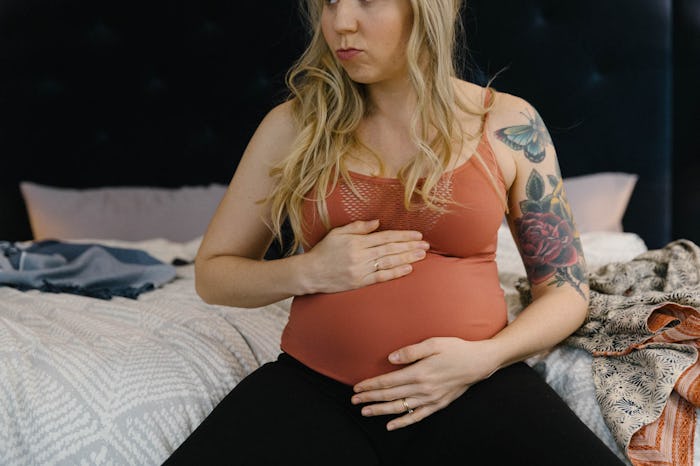Life
What Experts Want You To Know About Naturally Inducing Labor
While miraculous, pregnancy can seem like it will never end. You’re ready to drink wine and eat turkey sandwiches again, you’re ready to see your toes again, oh, and you're ready for your baby. At this point, you're willing to chug all of the hot sauce and eat all of the pineapple, but is it safe to naturally induce labor?
According to Dr. Adrienne Zertuche, an OB-GYN at a Division of Atlanta Women’s Healthcare Specialists, you really shouldn’t try to induce labor at home without discussing it with your OB-GYN first — it’s really unsafe. “In general, induction should only be done for a medical reason or if you have gone past your due date by one to two weeks. Typically, inductions are done in the hospital setting where your baby, contractions, and cervical change can be closely monitored. However, if you have had a low-risk and straightforward pregnancy, your obstetrician may be open to you trying to start the process at home once you reach 39 weeks,” Zertuche tells Romper in an email interview.
But there are some things you can do to speed the process along. Kristen Burris, L.Ac, a women’s health acupuncturist and infertility specialist tells Romper, “If a woman is not considered high risk, is not taking blood thinner medication, and her baby is in the proper birthing position with their head down, we encourage patients to begin receiving acupuncture during week 37 of their pregnancy. Acupuncture is the most effective natural treatment to begin labor."
“By choosing particular acupuncture points, we are strengthening the ‘kidney and spleen energy (Qi)’ to help give the mother energy to push the baby out, and we soften the ‘liver energy (Qi)’ to relax muscles, ease contractions, and reduce pain. From a western medical perspective, acupuncture initiates the release of oxytocin, the natural hormone released during labor that signals uterine contractions that are needed to help propel the baby down and out during labor,” Burris says.
But it's important to note that there isn't always a lot of scientific evidence for natural induction ideas. “While there are a number of old wives’ tales about things that women can try at home to stimulate spontaneous labor, most of them have not yet been proven in clinical trials,” Zertuche says in regard to natural induction methods you can do at home. “The most effective method is probably nipple stimulation. One recent study did suggest that eating six date fruits per day for four weeks prior to your due date may also make you more likely to go into labor on your own. In addition, some experts believe that exercise, sexual intercourse, acupuncture, and acupressure can stimulate spontaneous labor, but the evidence is not as strong,” she says.
Want to try something delicious anyway? Burris recommends “drinking six cups of red raspberry leaf tea daily, taking 1,200 milligrams of evening primrose oil (EPO) and walking” in addition to acupuncture, which can also be done in week 38 to start initiating labor and then in week 40, where they add in electrical stimulation to “further intensify to the brain that it’s time for baby to be born.”
As far as the EPO and raspberry leaf tea, Burris says that “the linolenic acid in EPO stimulates the production of natural prostaglandin, helping a woman’s cervix to soften and efface, or thin, so it can widen easily. Red raspberry leaf tea is best known for its ability to tone and strengthen the uterus, helping make contractions more efficient." She adds that “walking helps widen a woman’s hips, takes advantage of gravity, and your baby’s head puts pressure on your cervix, allowing more oxytocin to be released, helping to open and soften the cervix and allow baby out."
As far as natural ways your doctor can induce labor in a hospital, Zertuche says, “If you have been admitted to the hospital for an induction, your obstetrician is likely going to recommend that he or she help you into labor using the most effective and efficient methods, which include misoprostol, dinoprostone, a cervical balloon, oxytocin, and amniotomy. Less useful methods (e.g., nipple stimulation) are typically not recommended in the hospital setting.”
According to Zertuche, it’s really hard to say which of an obstetrician’s induction methods is more “natural” than the others, since they’re all meant to stimulate your body into going into labor. “One might favor an amniotomy, which is when your obstetrician uses a small plastic device to ‘break’ the bag of water surrounding your baby (an event that occurs spontaneously for some laboring women). Similarly, Pitocin is a synthetic version of the hormone naturally produced by the brain of a woman that is in spontaneous labor," she adds.
Whether you want to be induced naturally by your acupuncturist or at home, or if you want to get induced at a hospital, the most important thing to remember is you have to be at least 37 weeks along to begin acupuncture, and 39 weeks along to be cleared by your OB-GYN to be naturally induced. It’s important to discuss all induction methods with your healthcare provider to ensure that even the “natural” options are safe for you and your baby, based on your cervical exam.
